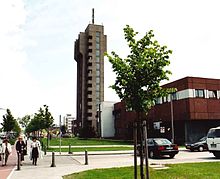Building Academy of the GDR
The Building Academy of the GDR (under this name as of January 1973) by decision of the Council of Ministers as the German Academy of Architecture (abbreviated as DBA) with effect from 1 January 1951 based on the summary of the Institute of Urban Planning and Construction and the Institute for Building (Director : Hans Scharoun ) of the German Academy of Sciences in Berlin (DAW). It had its headquarters in Berlin-Mitte , Hannoversche Strasse 28-30 and was opened on December 8, 1951 in a state ceremony. The DBA is historically part of the tradition of building academies in Germany, to which in particular the Berlin building academy belonged.
As a building academy, it was the central scientific institution for architecture and construction in the GDR . It had considerable practice-oriented research capacities in its institutes and was directly subordinate to the Ministry of Construction . It was headed by a President appointed by the Chairman of the Council of Ministers.
As a learned society , the Bauakademie had a maximum of 25 full and 30 candidate and corresponding members. The full and candidate members formed the plenum of the Bauakademie. They worked within the academy in departments (sections) and received a grant. The plenum discussed fundamental problems in the building industry; the sections were working bodies of the plenary, which in turn were divided into specialist groups. There were the sections economics , town planning and architecture , engineering-theoretical basics , project planning and computing technology , civil engineering , residential and social construction, industrial construction, agricultural construction, technical building equipment, engineering basics. The engineering fundamentals section had ten specialist groups for building mechanics, fire protection, acoustics, security, etc. Ä.
The building academy of the GDR had the right to award doctorates and awarded academic degrees ( Dr.-Ing. ) As well as awards (e.g. the plaque of honor "For outstanding achievements in building research"). The doctoral procedures were carried out by the Scientific Council .
Until 1973 it had its seat at Hannoversche Straße 28-30 in Berlin-Mitte, this building was later used as the permanent representation of the Federal Republic of Germany to the GDR . The building academy of the GDR was dissolved in the course of German reunification in 1991.
Its defining first president was the architect Kurt Liebknecht, who received his doctorate in the Soviet Union from 1951 to 1961 , a son of the chemist Otto Liebknecht and related to Wilhelm Liebknecht (grandfather) and Karl Liebknecht (uncle), two of the most famous protagonists the history of socialism in Germany .
Individual evidence
- ↑ Resolution on the commencement of the activities of the German Building Academy of January 25, 1951 (Journal of Laws p. 71)
- ^ A b Ludz Peter Christian Johannes Kuppe: GDR manual . Ed .: Federal Ministry for Internal German Relations. 1st edition. Verlag Wissenschaft und Politik, Cologne 1979, p. 134 .
- ↑ Biographical dataset on Kurt Liebknecht , online on the website of the Federal Foundation for the Processing of the SED Dictatorship (stiftung-aufverarbeitung.de/wer-war-wer-in-der-ddr), accessed on August 4, 2012


